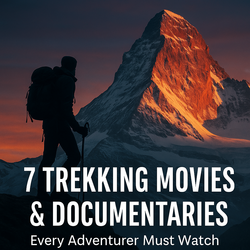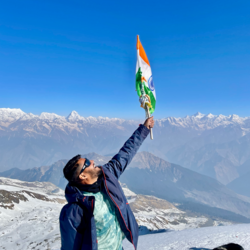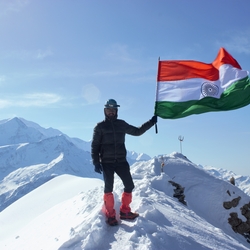Burrowed deep within the leafy jungles of the Kanchenjunga National Park, the coveted Goechala trek takes one disarmingly close to the third highest mountain range in the world. Boasting staggering views of ginormous peaks, stunning reflections mirrored faithfully in the serene waters of Samiti lake and long walks along suspension bridges lined with colorful prayer flags, this trek climbs up to a whopping 4600 M in altitude.

Traversing this trail that lets you meet the legendary Mt. Kanchenjunga face to face naturally has to come with its own set of challenges.
In this page, we will be discussing the difficulty level of the Goechala Trek along with the gear and skills you will need to negotiate the untrammelled terrain of the Kanchenjunga National Park effortlessly.
Difficulty level of the trek:
Goechala is a level 5 trek on the Bikat Rating Scale.
About the BRS: The Bikat Rating Scale rates the difficulty level of all treks and expeditions in our portfolio after taking into account their geographical and climatic conditions.
According to this scale, if you are a beginner who is unsure of your fitness level and don’t know what to expect on a trek, a trek rated one will be a good place to start.
If you liked your very first trekking experience and are looking to test your limits next, the treks rated 2 or 3 will do the job for you.
A beginner who is sure of their fitness level on the other hand is welcome to skip the first two levels and directly start with one of the treks rated 3.
From 4 onwards, the rules change a little. It is mandatory to have trekking experience of the previous level to participate in the next level.
The trails of Goechala
Apart from the long distances (>10 kms) you will be required to cover every day, the key challenge on the Goechala trek lies in acclimatizing to the altitude. The trail climbs from 1,780 M to 4,600 M. This is a gain of 2,820 M in a span of ten days. This means the trail will have many steep ascents to the summit.
Challenge 1: Acclimatization at Dzongri
While it is reasonable for a moderate-difficult trek, what makes this challenging is the forced altitude gain that happens on the 4th day between Tshoka (2,900M) and Dzongri (3,950 M). That is an ascent of over 1000M in a single day!
This, undeniably, is the most crucial section of the trek because it takes us well above the tree line. From our experience, many trekkers have faced difficulty acclimatizing to the sudden gain in altitude on this day.

Your acclimatization at Dzongri (3,950M) also plays a pivotal role in deciding whether you move ahead or turn back. The reason behind this is the altitude of the next campsite, Thansing (3800 M), which is located at a lower plane.
So if someone develops AMS symptoms after Dzongri, they will first have to gain altitude (to Dzongri) before losing height. Crucial time could get lost in the process because it is important to lose altitude as soon as possible when hit by AMS.
This is also the main reason Bikat Adventures has rated Goechala higher (BRS: 5) than some of its counterparts like Rupin Pass or KGL (BRS: 4).
Challenge 2: Summit Day
On the day of the summit, your trek begins at 3 AM if you are starting from Lamuney. In case, your trek leaders decided to stay back at Thansing the previous day to allow for better acclimatization, then your trek would begin at 1 AM.
The early start ensures that you are there at View Point 1 in time to watch the morning rays of the sun paint the Kanchenjunga range golden, a bewitching sight we promise will remain etched in your memory for a long time.
Since we aim to reach View Point One by sunrise, a major portion of your ascent to the summit will happen in the dark. So please ensure you carry your head torch with you.

Since we will be returning to Thansing on the same day, be prepared for a long day of trekking (13-17 km in 10-12 hours). The terrain is mostly moderate with gradual ascents and descents peppered by a couple of steep sections near Samiti Lake and View Point One.
A good fitness level is paramount to finishing strong on this day.
Challenge 3: Weather at Dzongri and Thansing
The phrase ‘blown away’ takes an altogether literal meaning at the campsites of Dzongri and Thansing.

The winds are fierce here, so fierce that you can hear them howl and rattle through the forest huts throughout your stay at these campsites.
This especially makes December a gruelling month to attempt the Goechala Trek.
There is hardly any snow on the trails during this time. But do not let this be a reason to underestimate the cold in the region. In fact, we have had trekkers tell us that Goechala in December should be rated a tad bit higher in terms of difficulty simply for its brutally cold winds from Dzongri and onwards.
Challenge 4: Long and Steep Descents
Since we will be retracing our path back to Yuksom, the steep ascents on the way to the summit become those steep descents while returning.
We will be covering the route from Thansing to Yuksom in a span of two days. This means we will be walking almost double the distance each day. This could place a lot of pressure on your knees and feet.

Gear Required for Goechala
While we will be providing most of the equipment needed for trekking (tents, sleeping bags, crampons, snow boots etc), there is some basic gear you will need from your end to get through your hike comfortably.
These are sturdy, a lightweight backpack and comfortable trekking shoes. In case, you plan on purchasing them, please refer to the articles below for some helpful tips on how to go about choosing the right gear for your trek.
A branded backpack can be a hefty spend when it comes to trekking. But this needn’t be the case if you know what to look for when purchasing one.
One of our founders, Pankaj, purchased a non-branded pack for INR 1100 in 2010 and the pack continues to work just fine for him. In the article linked above, he shares some helpful tips on what to look for when choosing a trekking backpack.
How to choose a good pair of hiking shoes
Conventional sports shoes don’t suit trekking trails. We recommend wearing high ankle shoes with sturdy soles. These not only provide better support but also reduce the possibility of injuries while hiking. Please refer to the guide linked above for some useful tips on choosing trekking shoes.
Skills required for Goechala
Bikat Adventures is primarily an adventure learning organization. This means our key objective is not just to help trekkers complete their treks but also to ensure they pick up some valuable lessons and skills in trekking along the way.
To achieve this, we have created learning modules and paired them to different levels on the Bikat Rating Scale.
These modules taught real-time on the trails by our trek leaders.
The following are some skills that are likely to come in handy on a trail like the Goechala.
While you will have all the assistance you need on the trek from our capable trek leaders and guides, we suggest browsing through the articles below to get an idea of what is involved.
Ascending and Descending on Trails
The Goechala trek involves long days of walking with steep ascents and descents. Maintaining the right rhythm and body posture can help avoid injuries and stress on your ankles and knees. The guide linked above shares some useful tips on how to ascend and descend down trails.
Given how cold it gets at night in the campsites of Goechala, you are likely to pull out all the winters clothes you have to layer up at night. This usually means having to re-pack your backpack in the mornings.
The article linked above shares some useful guidelines you can follow to pack efficiently.
Our trek leaders will be guiding you on how to pitch a tent during the trek. Nevertheless, we are linking the article above to anyone who might be interested in reading about it.
Layering appropriately to protect yourself from the cold is essential. The article linked above will give you a fair idea of the winter layers you will need and guide you on how to layer up at campsites and while hiking.
Trekking poles can come in handy while trekking, especially during descents. Please refer to the article above to find out the right way to use a trekking pole while hiking.
We hope this article answers all the questions you may have about the Goechala Trek. In case you need further assistance/information with something, please feel free to reach out to us. We are only a phone call away.






